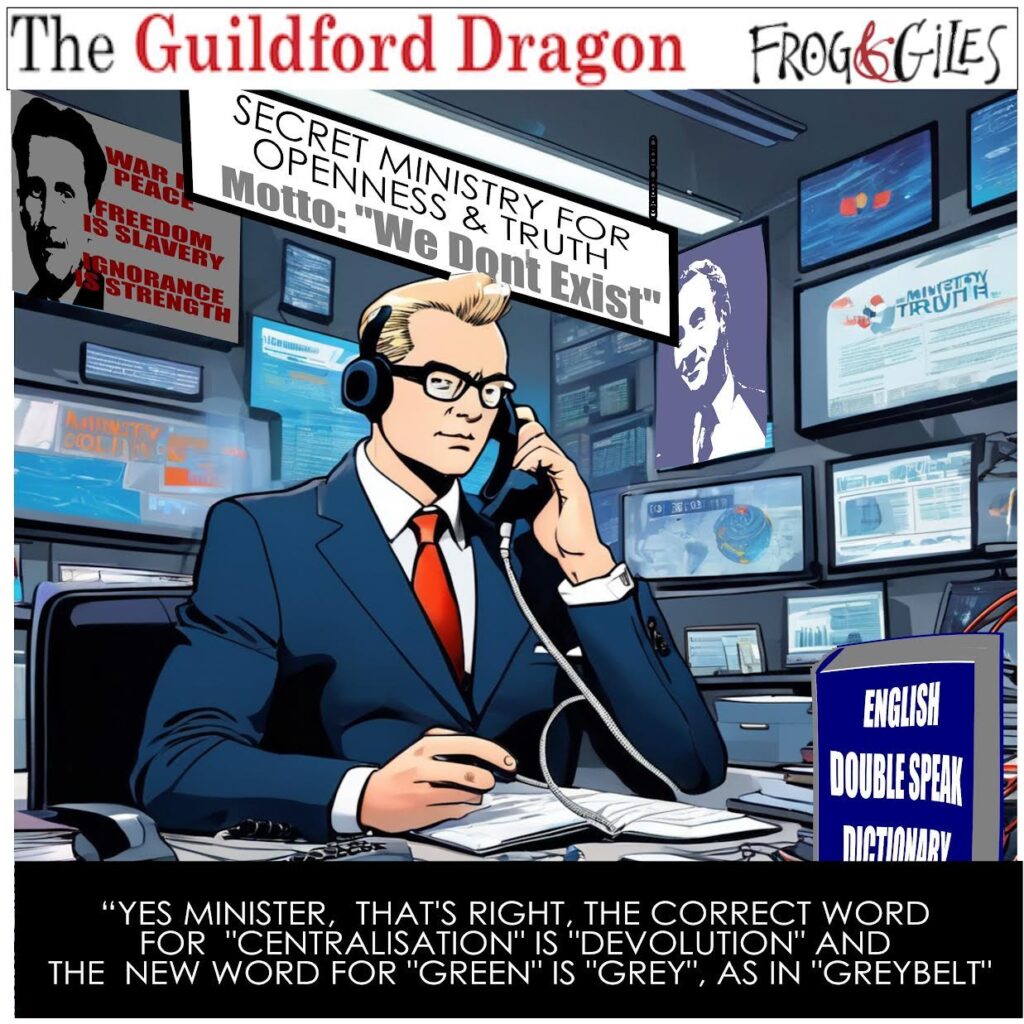 Abraham Lincoln
If given the truth, the people can be depended upon to meet any national crisis...
Abraham Lincoln
If given the truth, the people can be depended upon to meet any national crisis...
 Guildford news...
for Guildford people, brought to you by Guildford reporters - Guildford's own news service
Guildford news...
for Guildford people, brought to you by Guildford reporters - Guildford's own news service
Mole Valley Adopts Local Plan with Yearly Target of 336 New Homes
Published on: 24 Oct, 2024
Updated on: 25 Oct, 2024

Artistic impression of the plan for Arrival Square, Bull Hill, Leatherhead seen from North Street. Image: Mole Valley District Council and Keir Property
By Chris Caulfield
local democracy reporter
More than 6,000 new homes will be built in Mole Valley with Leatherhead taking on the largest share after the district council approved its long-term planning bible. But the plan might still be affected by top down housing targets proposed by central government under a new formula.
 Mole Valley District Council (MVDC), which borders the Borough of Guildford to the east, has agreed to build an average of 336 homes a year between 2020 and 2039 with town centre sites in Leatherhead, such as Bull Hill, and Dorking being set aside for large scale housing-led redevelopment.
Mole Valley District Council (MVDC), which borders the Borough of Guildford to the east, has agreed to build an average of 336 homes a year between 2020 and 2039 with town centre sites in Leatherhead, such as Bull Hill, and Dorking being set aside for large scale housing-led redevelopment.
The Mole Valley figure compares with 562 new homes per annum under the current Guildford Local Plan and a proposed imposed new target of 1,102 even though Guildford has a higher percentage of green belt 85 percent compared to Mole Valley’s 76 per cent.
To meet the MVDC target, complexes in Ashstead and Dorking have also been earmarked for regeneration, and green belt land in Ashstead, Bookham, Dorking and Leatherhead released so developers can build homes.
The council has also agreed to hand over green belt land for housing within and around Hookwood to “complement” economic growth near Gatwick.
Villages within the green belt, namely Beare Green, Brockham, Capel, Charlwood, and Westcott will have their boundaries amended to allow “appropriate development” after Mole Valley District Council formally adopted its Local Plan last week (October 15).
In all, Leatherhead is expected to take on 30 per cent of the new homes (1,914), followed by the areas around Dorking 23 per cent (1,467), Hookwood, 15 per cent (957), Ashtead, 11 per cent (701) and Bookham, seven per cent (446).
The remaining 14 per cent (893) will be spread across the rest of the district.
In Leatherhead, the council wants to create what it calls, a Riverside Quarter, at Claire House and James House in Bridge Street. This would go alongside an Urban Quarter at the redevelopment of the Bull Hill.
For Dorking, the Pippbrook House refurbishment remains its flagship development as well as plans to redevelop the Foundry Museum and Church Street workshops.
More locally, housing requirements for neighbourhood areas are as follows:
- Ashtead – 652 net new dwellings
- Bookham – 513 net new dwellings
- Capel Parish – 198 net new dwellings
- Ockley Parish – 135 net new dwellings
- Westcott – 123 net new dwellings
Mole Valley District Council, which passed its Local Plan by 28 votes to five with one abstention, said that 40 per cent of all new units would be affordable, and all come with at least one EV charging point.
The meeting heard that about 76 per cent of Mole Valley land was designated as Metropolitan Green Belt and protected from most forms of development.
Under its new plan, it said it has been able to deliver sites for housing while relinquishing less than one per cent of that.
Had the Local Plan not been agreed, developers would have had carte blanche to build without restrictions.
Cllr Margaret Cooksey, portfolio holder for planning on the Liberal Democrat run council, said: “It gives me enormous pleasure to be able to bring the Local Plan to this council for adoption at last.
“The Local Plan is about much more than a document about meeting housing need but a good deal of time and effort is taken up by worrying about specific development sites, particularly green belt sites.
“It’s worth noting again that only 0.65 per cent of the existing green belt in the district has been identified to be released for future development.
“There are sites in most of our wards that we wish were not there however I did say, that I felt that it was a fair plan in as much as what could be seen as pain was spread as evenly as possible across the district.”
Local plans go through long drawn-out processes before they are formally adopted, requiring sign off from planning inspectors.
Councils need to identify land for development and demonstrate it can meet housing targets. Often there is a trade off between town centre intensification or protecting green belt.
As well as the housing, the Mole Valley plan creates 230 new locally listed buildings and grants 27 parks and open spaces extra protection.
Dissenting voices in the chamber felt the council could have gone further to limit the impact on green belt while Cllr Chris Hunt (Independent, Ashtead Lanes and Common) said more could be done to curb building heights to stop town’s from becoming the next Woking.
He told the meeting: “This is not a sugar-coated pill for us to take, it’s got some very good things, affordable housing, the commitment for better health and education facilities, those are very positive things.
“But it’s also got some really hard to agree things.”
He added: “There is still quite a lot of uncertainty about whether a key site in our key town of Leatherhead can actually be developed or not.”
Adding: “It’s effectively saying that the plan’s foundations are uncertain in that regard and unfortunately it does echo something else, that there are no clearly defined density agreements.
“It has lots of good things but if I was on Strictly [Come Dancing] it would not be 10 out of 10, it would be a seven.”
Cllr Cooksey said: “We’re not Woking, Mole Valley is not Woking and we don’t want to look like Woking but there’s the dilemma between do we build in the green belt (or in the towns?)”
Cllr Leah Mursaleen-Plank (Liberal Democrat, Mickleham, Westcott and Okewood) said her ward has been hit by uncontrolled development “again and again” and called out at those asking to delay the plan’s adoption in order to protect more green belt.
She said: “There is no alternative here.
“We have been in a position in my ward where we haven’t had a Local Plan and we’ve had uncontrolled developments going through over and over again.
“We’re losing green belt by delaying further.
“To say that we need more time just means more development on green belt sites, the opposite of what you would like to achieve.”
Summing up Cllr Cooksey said: “I’m disappointed that we can’t say that it’s the overwhelming view of the whole council, it would have been very much stronger if we could have had support from the whole chamber.
“However we have an excellent plan here, I truly believe it and really think it’s probably the best we could probably have come up with under all the circumstances that we’ve had to deal with over the years.”
Mole Valley covers 26 sq kilometres, 16 per cent of Surrey as a whole and is the third largest borough in the county. It is a similar size to Guildford Borough which is very slightly larger with 27 sq kilometres.
Mole Valley’s population of 87,245 (compared to Guildford’s 146,000) accounts for seven per cent of Surrey’s total, while the average house price of £505,000 makes it second most expensive district in the county.
The ratio of house prices to residents’ salaries was 14:1 in March 2020, the fifth most unaffordable district in Surrey.
Between 2014 and 2019, 1,265 new homes were completed in Mole Valley – 230 of which were affordable.
Recent Articles
- ‘Emergency’ Roadworks Commence Without Warning, Closing The Portsmouth Road
- Police Investigate Public Order Offence in Walnut Tree Close
- Woman Arrested After Guildford Town Centre Assault – Witnesses Sought
- Guildford Among Top Quarter for Recycling Rejection Rates in the South East, New Data Reveals
- Highways Bulletin: Roadside Rangers Making a Visible Difference Across Surrey
- Letter: The Enduring Role of Parish and Town Councils
- Mr Carpenter’s Byfleet Seedling and Other Varieties of Apples
- Guildford MP Visits Local Satellite Firm During 40th Anniversary Year
- Letter: Only a Town Council Will Give Us to the Option to Choose on Some Local Services
- Comment: Parish Councils – Who Cares?



Search in Site
Media Gallery
Dragon Interview: Local Artist Leaves Her Mark At One of England’s Most Historic Buildings
January 21, 2023 / No Comment / Read MoreDragon Interview: Lib Dem Planning Chair: ‘Current Policy Doesn’t Work for Local People’
January 19, 2023 / No Comment / Read MoreA3 Tunnel in Guildford ‘Necessary’ for New Homes, Says Guildford’s MP
January 10, 2023 / No Comment / Read More‘Madness’ for London Road Scheme to Go Ahead Against ‘Huge Opposition’, Says SCC Leader
January 6, 2023 / No Comment / Read MoreCouncillor’s Son Starts Campaign for More Consultation on North Street Plan
December 30, 2022 / No Comment / Read MoreCounty Council Climbs Down Over London Road Works – Further ‘Engagement’ Period Announced
December 14, 2022 / No Comment / Read MoreDragon Interview: GBC Reaction to the Government’s Expected Decision to Relax Housing Targets
December 7, 2022 / No Comment / Read MoreHow Can Our Town Centre Businesses Recover? Watch the Shop Front Debate
May 18, 2020 / No Comment / Read More















Recent Comments